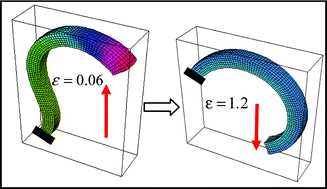Exploiting gradients in cross-link density to control the bending and self-propelled motion of active gels†
Abstract
Oscillating

- This article is part of the themed collection: Mechanoresponsive materials
* Corresponding authors
a
Chemical Engineering Department, University of Pittsburgh, Pittsburgh, PA, USA
E-mail:
balazs@pitt.edu
b Department of Materials Engineering, Graduate School of Engineering, The University of Tokyo, Tokyo, Japan
Oscillating

 Please wait while we load your content...
Something went wrong. Try again?
Please wait while we load your content...
Something went wrong. Try again?
O. Kuksenok, V. V. Yashin, M. Kinoshita, T. Sakai, R. Yoshida and A. C. Balazs, J. Mater. Chem., 2011, 21, 8360 DOI: 10.1039/C0JM03426F
To request permission to reproduce material from this article, please go to the Copyright Clearance Center request page.
If you are an author contributing to an RSC publication, you do not need to request permission provided correct acknowledgement is given.
If you are the author of this article, you do not need to request permission to reproduce figures and diagrams provided correct acknowledgement is given. If you want to reproduce the whole article in a third-party publication (excluding your thesis/dissertation for which permission is not required) please go to the Copyright Clearance Center request page.
Read more about how to correctly acknowledge RSC content.
 Fetching data from CrossRef.
Fetching data from CrossRef.
This may take some time to load.
Loading related content
